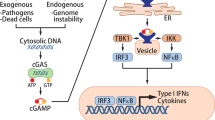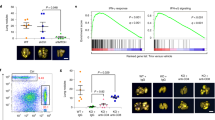Abstract
Smac mimetic compounds (SMC), a class of drugs that sensitize cells to apoptosis by counteracting the activity of inhibitor of apoptosis (IAP) proteins, have proven safe in phase 1 clinical trials in cancer patients. However, because SMCs act by enabling transduction of pro-apoptotic signals, SMC monotherapy may be efficacious only in the subset of patients whose tumors produce large quantities of death-inducing proteins such as inflammatory cytokines. Therefore, we reasoned that SMCs would synergize with agents that stimulate a potent yet safe “cytokine storm.” Here we show that oncolytic viruses and adjuvants such as poly(I:C) and CpG induce bystander death of cancer cells treated with SMCs that is mediated by interferon beta (IFN-β), tumor necrosis factor alpha (TNF-α) and/or TNF-related apoptosis-inducing ligand (TRAIL). This combinatorial treatment resulted in tumor regression and extended survival in two mouse models of cancer. As these and other adjuvants have been proven safe in clinical trials, it may be worthwhile to explore their clinical efficacy in combination with SMCs.
This is a preview of subscription content, access via your institution
Access options
Subscribe to this journal
Receive 12 print issues and online access
$209.00 per year
only $17.42 per issue
Buy this article
- Purchase on Springer Link
- Instant access to full article PDF
Prices may be subject to local taxes which are calculated during checkout





Similar content being viewed by others
References
Fulda, S. & Vucic, D. Targeting IAP proteins for therapeutic intervention in cancer. Nat. Rev. Drug Discov. 11, 109–124 (2012).
LaCasse, E.C. Pulling the plug on a cancer cell by eliminating XIAP with AEG35156. Cancer Lett. 332, 215–224 (2013).
Dougan, M. et al. IAP inhibitors enhance co-stimulation to promote tumour immunity. J. Exp. Med. 207, 2195–2206 (2010).
Vanneman, M. & Dranoff, G. Combining immunotherapy and targeted therapies in cancer treatment. Nat. Rev. Cancer 12, 237–251 (2012).
Gyrd-Hansen, M. & Meier, P. IAPs: from caspase inhibitors to modulators of NF-kappaB, inflammation and cancer. Nat. Rev. Cancer 10, 561–574 (2010).
Vandenabeele, P. & Bertrand, M.J. The role of the IAP E3 ubiquitin ligases in regulating pattern-recognition receptor signalling. Nat. Rev. Immunol. 12, 833–844 (2012).
Varfolomeev, E. et al. Cellular inhibitors of apoptosis are global regulators of NF-kappaB and MAPK activation by members of the TNF family of receptors. Sci. Signal. 5, ra22 (2012).
Beug, S.T., Cheung, H.H., LaCasse, E.C. & Korneluk, R.G. Modulation of immune signalling by inhibitors of apoptosis. Trends Immunol. 33, 535–545 (2012).
Mahoney, D.J. et al. Both cIAP1 and cIAP2 regulate TNFalpha-mediated NF-kappaB activation. Proc. Natl. Acad. Sci. USA 105, 11778–11783 (2008).
Li, L. et al. A small molecule Smac mimic potentiates TRAIL- and TNF{alpha}-mediated cell death. Science 305, 1471–1474 (2004).
Varfolomeev, E. et al. IAP antagonists induce autoubiquitination of c-IAPs, NF-kappaB activation, and TNFalpha-dependent apoptosis. Cell 131, 669–681 (2007).
Vince, J.E. et al. IAP antagonists target cIAP1 to induce TNFalpha-dependent apoptosis. Cell 131, 682–693 (2007).
Petersen, S.L. et al. Autocrine TNFalpha signalling renders human cancer cells susceptible to Smac-mimetic-induced apoptosis. Cancer Cell 12, 445–456 (2007).
Gaither, A. et al. A Smac mimetic rescue screen reveals roles for inhibitor of apoptosis proteins in tumour necrosis factor-alpha signalling. Cancer Res. 67, 11493–11498 (2007).
Cheung, H.H., Mahoney, D.J., Lacasse, E.C. & Korneluk, R.G. Down-regulation of c-FLIP Enhances death of cancer cells by smac mimetic compound. Cancer Res. 69, 7729–7738 (2009).
Cheung, H.H. et al. Smac mimetic compounds potentiate interleukin-1 beta-mediated cell death. J. Biol. Chem. 285, 40612–40623 (2010).
Kawai, T. & Akira, S. The role of pattern-recognition receptors in innate immunity: update on Toll-like receptors. Nat. Immunol. 11, 373–384 (2010).
Chen, G., Shaw, M.H., Kim, Y.G. & Nunez, G. NOD-like receptors: role in innate immunity and inflammatory disease. Annu. Rev. Pathol. 4, 365–398 (2009).
McFadden, G., Mohamed, M.R., Rahman, M.M. & Bartee, E. Cytokine determinants of viral tropism. Nat. Rev. Immunol. 9, 645–655 (2009).
Russell, S.J., Peng, K.W. & Bell, J.C. Oncolytic virotherapy. Nat. Biotechnol. 30, 658–670 (2012).
Houghton, P.J. et al. Initial testing (stage 1) of LCL161, a SMAC mimetic, by the Pediatric Preclinical Testing Program. Pediatr. Blood Cancer 58, 636–639 (2012).
Chen, K.F. et al. Inhibition of Bcl-2 improves effect of LCL161, a SMAC mimetic, in hepatocellular carcinoma cells. Biochem. Pharmacol. 84, 268–277 (2012).
Dhuria, S. et al. Time-dependent inhibition and induction of human cytochrome P4503A4/5 by an Oral IAP Antagonist, LCL161, in vitro and in vivo in healthy subjects. J. Clin. Pharmacol. 53, 642–653 (2013).
Breitbach, C.J. et al. Targeted inflammation during oncolytic virus therapy severely compromises tumour blood flow. Mol. Ther. 15, 1686–1693 (2007).
Vaha-Koskela, M.J. et al. Resistance to two heterologous neurotropic oncolytic viruses, Semliki Forest virus and vaccinia virus, in experimental glioma. J. Virol. 87, 2363–2366 (2013).
Le Boeuf, F. et al. Model-based rational design of an oncolytic virus with improved therapeutic potential. Nat. Commun. 4, 1974 (2013).
Kawai, T. & Akira, S. Innate immune recognition of viral infection. Nat. Immunol. 7, 131–137 (2006).
Kirshner, J.R., Karpova, A.Y., Kops, M. & Howley, P.M. Identification of TRAIL as an interferon regulatory factor 3 transcriptional target. J. Virol. 79, 9320–9324 (2005).
Bose, S., Kar, N., Maitra, R., DiDonato, J.A. & Banerjee, A.K. Temporal activation of NF-kappaB regulates an interferon-independent innate antiviral response against cytoplasmic RNA viruses. Proc. Natl. Acad. Sci. USA 100, 10890–10895 (2003).
Rosenfeld, M.R. et al. A multi-institution phase II study of poly-ICLC and radiotherapy with concurrent and adjuvant temozolomide in adults with newly diagnosed glioblastoma. Neuro-oncol. 12, 1071–1077 (2010).
Butowski, N. et al. A phase II clinical trial of poly-ICLC with radiation for adult patients with newly diagnosed supratentorial glioblastoma: a North American Brain Tumour Consortium (NABTC01–05). J. Neurooncol. 91, 175–182 (2009).
Butowski, N. et al. A North American brain tumour consortium phase II study of poly-ICLC for adult patients with recurrent anaplastic gliomas. J. Neurooncol. 91, 183–189 (2009).
Krieg, A.M. CpG still rocks! Update on an accidental drug. Nucleic Acid Ther. 22, 77–89 (2012).
Erickson, R.I. et al. Toxicity profile of small-molecule IAP antagonist GDC-0152 is linked to TNF-alpha pharmacology. Toxicol. Sci. 131, 247–258 (2013).
Wong, H. et al. Dogs are more sensitive to antagonists of inhibitor of apoptosis proteins than rats and humans: a translational toxicokinetic/toxicodynamic analysis. Toxicol. Sci. 130, 205–213 (2012).
Cantaert, T., Baeten, D., Tak, P.P. & van Baarsen, L.G. Type I IFN and TNFalpha cross-regulation in immune-mediated inflammatory disease: basic concepts and clinical relevance. Arthritis Res. Ther. 12, 219 (2010).
Yarilina, A. & Ivashkiv, L.B. Type I interferon: a new player in TNF signalling. Curr. Dir. Autoimmun. 11, 94–104 (2010).
Lu, J. et al. Therapeutic potential and molecular mechanism of a novel, potent, nonpeptide, smac mimetic SM-164 in combination with TRAIL for cancer treatment. Mol. Cancer Ther. 10, 902–914 (2011).
Sun, H. et al. Design, synthesis, and characterization of a potent, nonpeptide, cell-permeable, bivalent Smac mimetic that concurrently targets both the BIR2 and BIR3 domains in XIAP. J. Am. Chem. Soc. 129, 15279–15294 (2007).
Bertrand, M.J. et al. cIAP1 and cIAP2 facilitate cancer cell survival by functioning as E3 ligases that promote RIP1 ubiquitination. Mol. Cell 30, 689–700 (2008).
Enwere, E.K. et al. TWEAK and cIAP1 regulate myoblast fusion through the noncanonical NF-kappaB signalling pathway. Sci. Signal. 5, ra75 (2012).
Stojdl, D.F. et al. VSV strains with defects in their ability to shutdown innate immunity are potent systemic anti-cancer agents. Cancer Cell 4, 263–275 (2003).
Brun, J. et al. Identification of genetically modified Maraba virus as an oncolytic rhabdovirus. Mol. Ther. 18, 1440–1449 (2010).
Le Boeuf, F. et al. Synergistic interaction between oncolytic viruses augments tumour killing. Mol. Ther. 18, 888–895 (2010).
Lun, X. et al. Efficacy and safety/toxicity study of recombinant vaccinia virus JX-594 in two immunocompetent animal models of glioma. Mol. Ther. 18, 1927–1936 (2010).
Mikus, J. & Steverding, D. A simple colorimetric method to screen drug cytotoxicity against Leishmania using the dye Alamar Blue. Parasitol. Int. 48, 265–269 (2000).
Chou, T.C. & Talaly, P. A simple generalized equation for the analysis of multiple inhibitions of Michaelis-Menten kinetic systems. J. Biol. Chem. 252, 6438–6442 (1977).
Acknowledgements
We thank D. Porter, B. Firestone, L. Zawel and J.S. Cameron of Novartis for providing LCL161. We thank S. Wang (University of Michigan) for providing SM-122 and SM-164. We thank R. Al-awar and her medicinal chemistry team at the Ontario Institute for Cancer Research (OICR) for providing OICR720. We thank S. Pichette for her assistance with the creation of VSVΔ51-TNF-α. This work is supported by grants awarded to R.G.K. by the Canadian Institutes of Health Research (CIHR, MOP #86627), the Ottawa Regional Cancer Foundation (ORCF), the Ottawa Kiwanis Medical Foundation, the Children's Hospital of Eastern Ontario (CHEO) Foundation, and The Lotte & John Hecht Memorial Foundation Innovation Grant of the Canadian Cancer Society. J.C.B. is supported by OICR and The Terry Fox Foundation. F.L.B. was supported by an industrial fellowship from CIHR. D.J.M. is the recipient of a New Investigator Award from the Alliance for Cancer Gene Therapy (USA). R.G.K. is a Fellow of the Royal Society of Canada and a distinguished professor of the University of Ottawa. We thank D. Stojdl (Children's Hospital of Eastern Ontario Research Institute) for SNB75.
Author information
Authors and Affiliations
Contributions
S.T.B., E.C.L., V.A.T., F.L.B., D.J.M. and R.G.K. designed the experiments. S.T.B., H.H.C., J.P.N., N.E., M.S.-J., J.H., C.E.B., V.A.T., F.L., C.I., H.D. and J.B. conducted experiments. S.T.B., E.C.L., V.A.T., J.C.B., D.J.M. and R.G.K. wrote the manuscript.
Corresponding author
Ethics declarations
Competing interests
R.G.K. is a scientific founder and shareholder of Aegera Therapeutics (Pharmascience Inc., Montreal, Canada) which has an SMC under clinical development. J.C.B. is the Chief Scientific Officer and a shareholder of Jennerex (Ottawa, Canada and San Francisco, USA), which has a Vaccinia-based oncolytic virus under clinical development.
Supplementary information
Supplementary Text and Figures
Supplementary Figures 1–19 and Supplementary Tables 1 and 2 (PDF 3891 kb)
Rights and permissions
About this article
Cite this article
Beug, S., Tang, V., LaCasse, E. et al. Smac mimetics and innate immune stimuli synergize to promote tumor death. Nat Biotechnol 32, 182–190 (2014). https://doi.org/10.1038/nbt.2806
Received:
Accepted:
Published:
Issue Date:
DOI: https://doi.org/10.1038/nbt.2806
This article is cited by
-
Immunogenic cell death in cancer: targeting necroptosis to induce antitumour immunity
Nature Reviews Cancer (2024)
-
Immunotherapies targeting stimulatory pathways and beyond
Journal of Hematology & Oncology (2021)
-
BH3-mimetics: recent developments in cancer therapy
Journal of Experimental & Clinical Cancer Research (2021)
-
Role of RIPK1 in SMAC mimetics-induced apoptosis in primary human HIV-infected macrophages
Scientific Reports (2021)
-
Improving antitumor efficacy via combinatorial regimens of oncolytic virotherapy
Molecular Cancer (2020)



